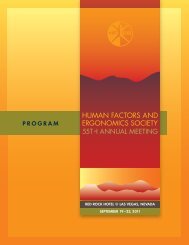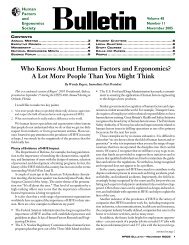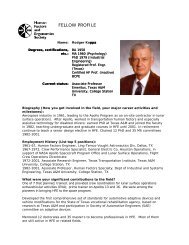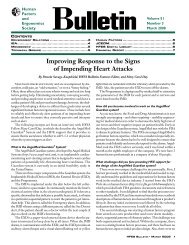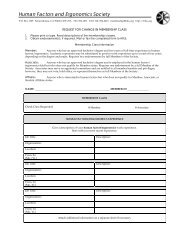Next Generation Air Transportation System Integrated Plan
Next Generation Air Transportation System Integrated Plan
Next Generation Air Transportation System Integrated Plan
You also want an ePaper? Increase the reach of your titles
YUMPU automatically turns print PDFs into web optimized ePapers that Google loves.
Chapter 3: <strong>System</strong> Goals and<br />
Performance Characteristics<br />
To achieve our vision, we need to define the system goals and<br />
performance characteristics that will serve as its foundation.<br />
Accordingly, we aim to:<br />
• Retain U.S. leadership in global aviation<br />
• Expand capacity<br />
• Ensure safety<br />
• Protect the environment<br />
• Ensure our national defense<br />
• Secure the nation<br />
As we continue to refine this effort we will periodically revisit<br />
these goals to ensure we have established the most cost beneficial<br />
system.<br />
3.1 Retain U.S. Leadership in Global Aviation<br />
<strong>Air</strong> transportation fuels the global economy by delivering goods<br />
and facilitating the movement of people for business and personal<br />
purposes. Already a third of U.S. exports by value are shipped by<br />
air. 8 <strong>Air</strong> transportation will expand with global commerce. The<br />
number of international air travelers will triple by 2025. 9 10 11 The<br />
expansion will include direct access to a wider range of foreign<br />
destinations and global markets through liberalization agreements<br />
such as Open Skies Agreements.<br />
Continued expansion depends in part on productivity gains and cost<br />
savings. Costs associated with system improvements will not put<br />
undue burdens on military, commercial, and private aircraft owners.<br />
The aviation-manufacturing sector—airframes, avionics, air traffic<br />
control and surveillance technologies—all play an important role<br />
in the U.S. economy and remain a critical aspect of our national<br />
defense. The vitality of U.S. aviation manufacturers will strengthen<br />
as government concentrates on establishing performance-based<br />
standards while industry develops innovative products to capture<br />
new markets.<br />
Specialty services tailored to individual customer needs, such as<br />
on-demand general aviation, will become part of the system. 12 Over<br />
the next 20 years, market projections for microjets and unmanned<br />
vehicles number in the tens of thousands. 13 14 In the same period, it<br />
is projected the cumulative value of aircraft sales and aircraft service<br />
markets will exceed $2 trillion. 15 It is essential that we establish a<br />
clear vision for the future of this sector based on the least restrictive<br />
regulatory environment possible consistent with safety and security<br />
requirements. Only when that vision is spelled out will we unleash<br />
the energy and creativity of America’s aerospace industry in ways<br />
that will ensure the future of the air transportation system.<br />
Objectives<br />
• Retain our role as the world leader in aviation<br />
• Reduce costs for air transportation<br />
• Enable services tailored to traveler and shipper needs<br />
• Encourage performance-based, harmonized global standards<br />
for U.S. products and services to keep new and existing markets<br />
open<br />
3.2 Expand Capacity<br />
The air transportation system of 2025 must accommodate a wide-range<br />
of customers and an even wider spectrum of issues including:<br />
• Access requirements for private, commercial, civil, and<br />
military aviation<br />
• Unforeseen changes in traveler and shipper needs<br />
• Access to a more global economy<br />
• Continuously evolving safety and security concerns<br />
<br />
<br />
<br />
<br />
<br />
<br />
<br />
<br />
<br />
<br />
<br />
<br />
<br />
<br />
<br />
<br />
<br />
<br />
8 Bureau of Census, 2003.<br />
9 Based upon extrapolated growth rates reported in Federal Aviation Administration, FAA Aerospace<br />
Forecasts FY 2004 – 2015, March 2004.<br />
10 Boeing, Current Market Outlook, 2004.<br />
11 <strong>Air</strong>bus, Global Market Forecast, 2003.<br />
12 Federal Aviation Administration, Future <strong>Air</strong>port Capacity Task - Final Report, June 2004.<br />
13 Dollyhigh, Samuel, Analysis of Small <strong>Air</strong>craft as a <strong>Transportation</strong> <strong>System</strong>, NASA September 2002.<br />
14 Teal Group, World Unmanned Aerial Vehicle <strong>System</strong>s – Market Profile and Forecast, 2003.<br />
15 Boeing, Current Market Outlook, 2004.<br />
Joint <strong>Plan</strong>ning & Development Office 07



